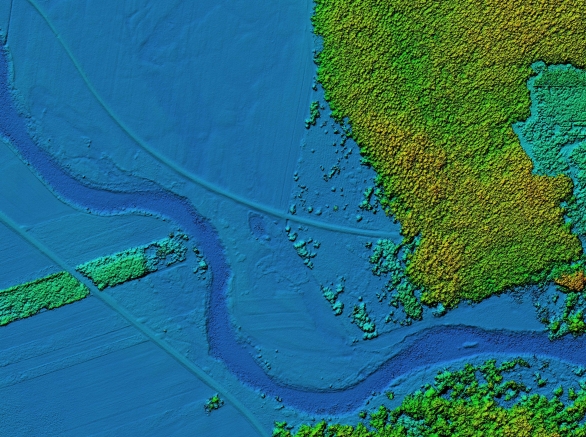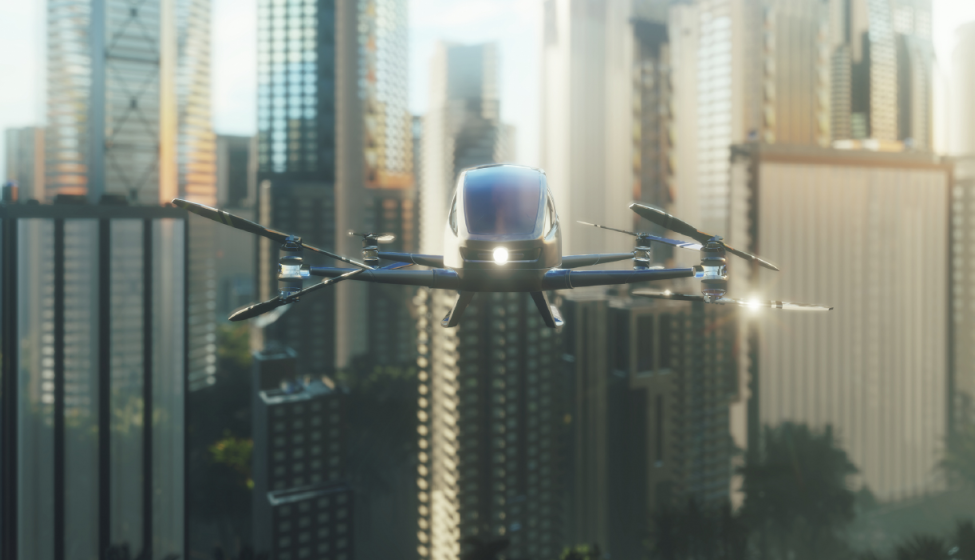April 14, 2022
Five questions for progressing on the path toward electrified flight
On May 16, 1977, 5:32 p.m. EST, a New York Airways helicopter landed on the Pan Am Building in Midtown Manhattan to retrieve guests and then return to JFK International Airport, where its passengers would be able to embark on their flight seamlessly. It was a vision, some 45 years ago, of what is now termed "urban air mobility" (UAM).
Although such airport transfer services remain available in New York City and many other places, the events of that day have become a cautionary tale for flight over crowded cities. A little more than two minutes after touching down, the helicopter tipped on its side when the right landing gear failed, and the running rotor blades struck the rooftop helipad. The flight crew and four passengers inside sustained minor injuries, but four more passengers waiting to board were killed, as well as a pedestrian on Madison Avenue nearly 900 feet below when a blade that had broken in two flew over the edge of the building.
As a result, New York City has remained cautious about expanding UAM for decades (a 2019 crash in Midtown Manhattan reinvigorated calls for non-essential helicopters to be banned), and the Pan Am Building incident serves as an example of issues that have limited UAM in large would-be markets, despite its potential benefits.
Today, thanks to huge strides in technology and capital investment-making headlines, the promise of UAM flights has never been closer — only the focus is no longer on standard vertical take-off and landing (VTOL) helicopters but electric ones (eVTOL) that could someday function like app-based ride services.
The proposed benefits of electrified UAM are many and frequently tied to the demand for a greener economy.
Supporters suggest advantages ranging from improved last-mile delivery services to less congested freeways and roads, and agencies such as NASA and the FAA have added credibility by partnering to "accelerate the realization of emerging aviation markets for passenger and cargo transportation in urban, suburban, rural, and regional environments" through targeted campaigns. North America and Europe are positioned as forerunners of this emerging multibillion-dollar global market.
But several practical concerns still stand in the way of electrified UAM. Are battery-powered helicopters more environmentally friendly than other alternative modes of transport? Is electrified UAM safe — or safe enough to overcome prior resistance to UAM? Is there a consumer market or infrastructure to support the eVTOL aircraft now in development?
These and other challenges pose obstacles for a variety of stakeholders, including the aviation industry, capital investment firms, aeronautical engineers, energy storage experts, government entities, regulatory agencies, and associated legal teams. As an entry point into a complex and developing sector, here are five considerations for the future of electrified UAM.
Preparing for liftoff
Are UAM eVTOL aircraft part of a greener economy?
Battery technologies are improving year over year, and the world's engineers and scientists continue striving for safer, lighter, longer-lasting energy storage solutions. Flying will always be more energy intensive than ground transport, but with shorter routes, less congestion, and integration with ground transport, air travel may be able to improve some of the imbalance of energy that flight demands.
Assessments on the environmental impact of UAM will likely be contested and even produce contradictory conclusions as different researchers obtain different results. Contradictory results are common during the early years of rapidly developing technologies due to varying assumptions between researchers in situations where parameters have yet to be established through practice and experience.
As a result, UAM companies may need to perform robust validations of the assumptions behind their analyses to deliver reliable assessments to investors, customers, and regulators.
2. How will UAM be regulated?
Unmanned aerial vehicles (UAVs), or "drones," provide a good example of how UAM regulations are likely to play out. In 2016, the FAA made it possible to operate commercial UAVs that comply with current standards and current pilot training requirements.
Since then, additional regulations have been added that clarify or expand initial policies, such as remote identification regulation published in 2021 and the ability to fly drones at night. This appears to bode well for manned eVTOL aircraft. The FAA has indicated, as mentioned above, that it is actively preparing for a future that integrates electrified UAM into aviation infrastructure — but it's important to keep in mind that new aircraft designs will require new certification standards for pilots and the aircraft itself. This can be seen with manned versus unmanned aircraft, which have very different risk profiles and thus very different regulations.
Another key point is that while the FAA regulates the National Airspace System (NAS), takeoff and landing can be regulated locally. This may create a patchwork system where heliports (or vertiports) are prevalent in some cities while absent in others.
For instance, today there are only three heliports in New York City compared to dozens in Los Angeles. Whereas New York has a track record of caution, Los Angeles required helipads on buildings over 75 feet for decades because of their value to emergency services and fire response.
Citizen complaints eventually led to the law being rescinded in 2014. These same dynamics are certain to impact the future of electrified UAM, as public tolerance for environmental impacts, noise, and potential safety issues will be a powerful factor in how local authorities proceed.
3. Is there enough customer demand for UAM?
The idea of "flying cars" has excited the public for a very long time (think of "Chitty Chitty Bang Bang", "The Jetsons", "Blade Runner", or "Back to the Future"), and UAM is a realization of this interest. Public and private partnerships and investments in electrified UAM as well as overall electric mobility (vehicles, e-scooters, e-bikes, etc.) are good indicators of momentum as well as willingness to solve logistics and regulatory challenges.
Education around electrified UAM aircraft, like driverless vehicles, will be necessary and ongoing as pilot programs begin surfacing. However, the pace of expansion will depend heavily on the development costs of these new aircraft. Historically, it has been extremely expensive to develop new aircraft, though recent technologies might be able to reduce time and maintenance costs.
4. Is electrified UAM safe?
Flight comes with both inherent safety risks and advantages. For example, commercial flight is widely known to be safer than driving and continues to improve globally, decade over decade. Electrified UAM, which will rely heavily on batteries and automation and very different aerodynamics, will require time to develop and evolve to a level that meets the necessary safety expectations of investors, customers, and regulators.
Multidisciplinary inputs ranging from material, electrical, and mechanical issues to software automation and human factors issues will be needed to facilitate comprehensive assessments on par with those now being conducted for electric and advanced driver assistance systems (ADAS) vehicles.
5. What happens when a UAM eVTOL aircraft fails?
Electrified UAM aircraft tests are already taking place all over the world. Failures, unfortunately, are bound to occur as the technology develops and as electrified UAM becomes more prevalent. For all failures, acting quickly is critical to preserving evidence (physical, digital, and witness accounts) and conducting analyses, as well as providing accurate, unbiased, and non-speculative information to regulators, consumers, and investors.
For existing airflight, National Transportation Safety Board (NTSB) regulations require that accidents be reported promptly, and that evidence is preserved, which is also the case for electrified UAM aircraft.
Precise technical communication about the design and available data on an incident will also be essential. Trained accident investigators with experience in aircraft failure investigations, ADAS vehicle investigations, battery failures, material failures, motor failures, and human factors may all be required. In some cases, authorities may alter a crash scene to render it safe (such as emptying a fuel tank or discharging a battery), however, such actions can lead to a loss of pertinent data. This scenario can be avoided with effective technical representation capable of assisting authorities with ensuring a scene is safe in a non-destructive manner.
How Exponent Can Help
Exponent supports clients in solving their most challenging technical barriers from product conception, design, and prototyping to performance, recall, and risk. Our broad expertise across numerous engineering disciplines, public health, and ecological and environmental sciences gives our clients access to an unparalleled set of skills and resources that can help build unique solutions to unprecedented challenges. Our past work in similar developing areas with evolving regulations such as UAVs and electric and ADAS-equipped vehicles informs our perspective on key elements for bringing new technologies to market, including design review and validation planning, risk and safety assessments, regulatory and compliance concerns, failure analysis and investigation, environmental impact studies, and more.



